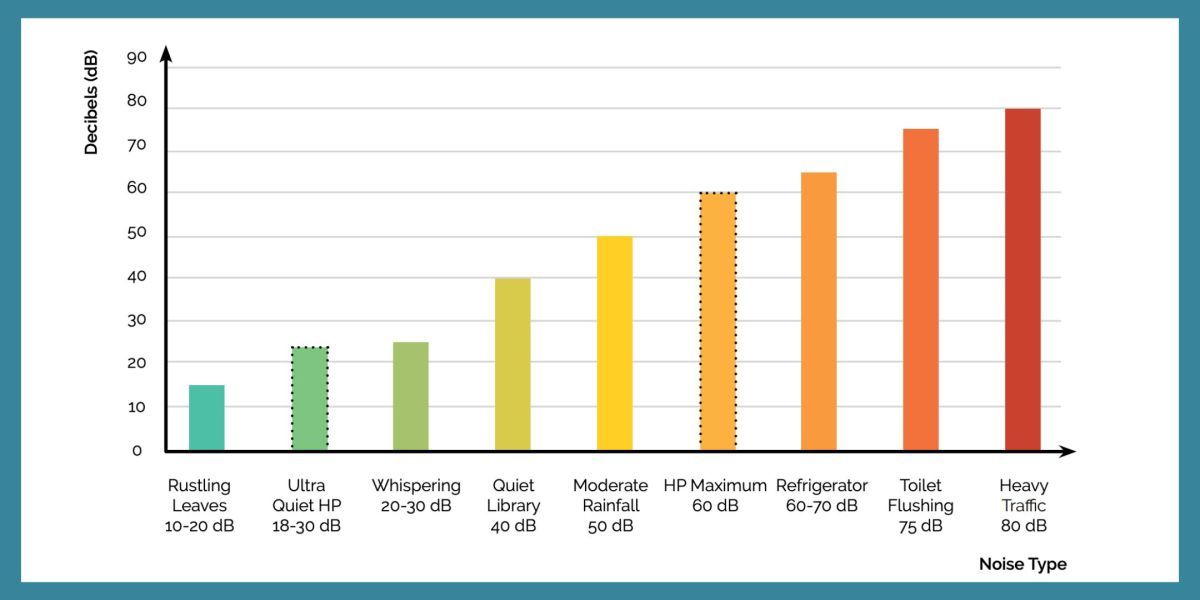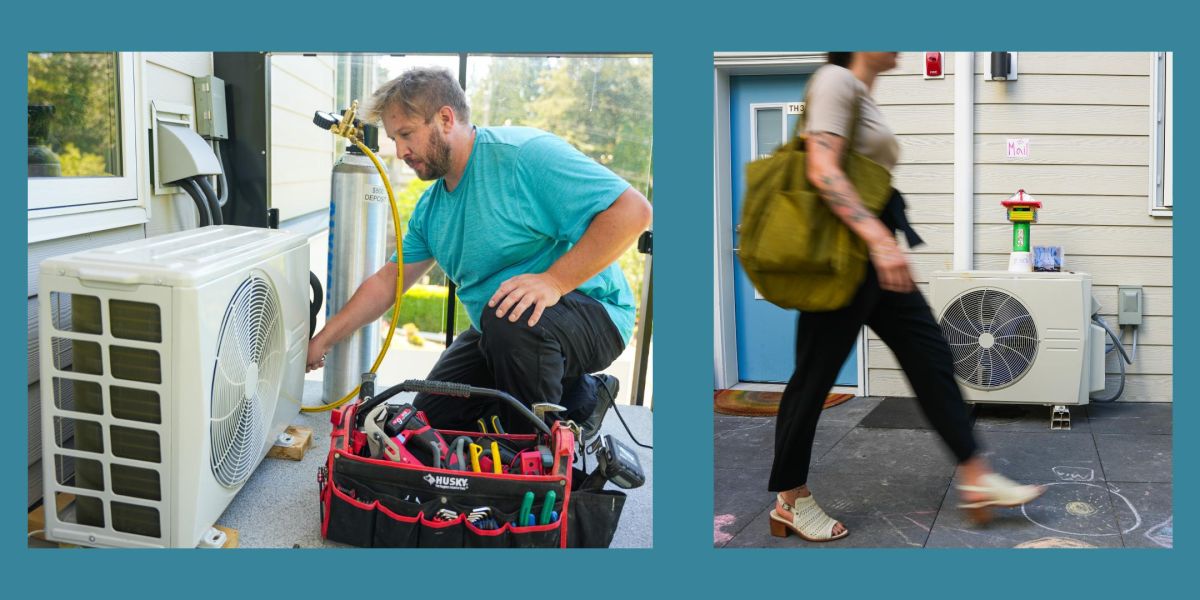
The Faught family are residents of the Driftwood Village Cohousing (DVC) complex in North Vancouver, BC (Climate Zone 4). The complex is an all-electric building, consisting of 27 strata-titled suites in a 5-storey wood-framed building. Recently built in 2021, DVC has triple-glazed windows and good insulation which keeps energy bills low. The development includes baseboard electric heating in each suite, a centralized Sanden CO2 heat pump water heater (HPWH) system, and ventilation provided by high-efficiency Zehnder heat recovery ventilators (HRV).
DVC is a cohousing community, but the building operates as a traditional strata corporation. When Brady Faught and his family decided to pursue the installation of a heat pump, they needed to get the strata council on board with the idea. As a staff member of the City of Vancouver’s Green Buildings Team, Brady helps to develop green building policies and regulations that mandate electric heating in new buildings and incentivize the installation of heat pumps in existing buildings through rebates and supports. As a result, Brady was well-versed in heat pump technology and the potential hurdles that individuals come across when they want to install heat pumps in their suites.
Like many condo owners, the Faughts found it difficult to cool down their suite during hot summer days. They also found electric baseboards expensive to operate in the winter. This motivated their interest in heat pumps, which can provide heating and cooling at a low operating cost.
Getting the Strata on Board
In January 2022, Brady presented basic information on heat pumps to the strata council and residents. Four common areas of concern came up for residents:
- Impact of wall penetrations with respect to rain, insurance and the 2-5-10 warranty
- Noise from outdoor units
- Trustworthiness of contractors and quality of work
- Visibility of outdoor units and the impact on building aesthetics
As the journey progressed, seven other suites decided to install heat pumps as well. Given the interest and concerns of the community, the strata council decided to establish a set of guidelines for homeowners to follow when installing a heat pump.
Concern 1: Wall penetrations
The fears around wall penetrations were mitigated by speaking to a building envelope consultant. Their advice was to make the wall penetration under a balcony and properly seal the penetration. This approach would avoid the need to have a building envelope consultant review and approve each penetration. The strata council was reassured that a small penetration under a balcony or overhang posed very minimal risk of water penetration.
Approved DVC Criteria for Wall Penetrations
- Locate the penetration under a balcony or roof overhang
- Ensure that the penetration is accessible from both indoors and outside
- Ensure that piping connections are not located in wall cavity
- Seal the sleeve with silicone sealant, tape, or foam
- Direct the condensate to a drain, not on walkable surfaces
If any owners want additional oversight of the wall penetration, they can hire a building envelope consultant.

Image 1: Close-up example of wall penetration. Image 2: Heat pump installed on patio under roof overhang, with Brady Faught.
Concern 2: Noise
Given that tolerance to noise is subjective, it was challenging to reassure residents without hearing a heat pump in operation. Brady conducted noise testing to demonstrate that the background noise of vehicles on the adjacent road is much louder than the hot water heat pumps located in the parkade. He also arranged a tour of a Vancouver housing co-op that recently installed a heat pump for each suite. During the tour, residents were able to listen to and see the heat pumps in action.

Table: Comparison of various location and their average sounds and noise levels

Graph: Decibel levels heat pumps compared with common noises
Approved DVC Criteria for Noise
- Outdoor units must have variable speed compressors. Noise is reduced as units ramp up gradually and whenever the compressor is running at less than 100% capacity. Outdoor units should have a maximum noise rating below approximately 60 dB
- Install outdoor units on high-quality anti-vibration pads
Concern 3: Contractor Selection
The residents interested in a heat pump debated whether to hire one contractor to install all the heat pumps or leave it to each owner to hire a contractor based on individual budgets. They decided on the latter, and in the end, three different contractors installed the systems. The chosen contractors had quoted a mid-range price, proposed to install name brand equipment (e.g. Fujitsu), had capacity to complete the work before summer, and gave the owners a sense of confidence in their ability to provide a quality installation.
Approved DVC Criteria for Contractors and Contracts
- Hire qualified, experienced, insured & bonded / licensed contractors with good references and who are members of TECA, HRAI, or Home Performance Contractor Network. Refer to this B2E article for more information about hiring a contractor
- Hire licensed electricians
- Ensure that contractors obtain municipal permits, as required
Note: it is recommended that homeowners do not pay the balance of their invoices until they have received and reviewed a verification report from their contractor confirming that the work has been completed in accordance with the specifications, and all applicable maintenance and warranty documentation has been received. Most contracts will involve a deposit with the balance due upon completion, but there is typically a "pay within 30 days to avoid late interest charges".

Image 3: Contractor Colin Milne, installing an exterior unit at DVC. Image 4: DVC resident walking in front of a heat pump outdoor unit.
Concern 4: Aesthetics and Visibility
In a mild climate such as North Vancouver’s, the public is not accustomed to seeing mechanical equipment on the exterior of a home. As heat pumps gain popularity, the sight of these units will become less of a concern. However, given the residents’ feedback about aesthetics, DVC developed criteria to address this concern.
Approved DVC Criteria for Aesthetics and Unit Location
- Outdoor units should not be located on common exterior walkways, except for in the courtyard
- Outdoor units should be located where they are least visible (on private balconies and patios for ground-floor suites) placement prioritized for least visibility on private balconies
- Outdoor systems are to be ground mounted
- Outdoor units should be located to minimize the length of the outdoor line set
- Outdoor PVC covers can be paint-matched where visible from the courtyard or street.
By April 2022, the board/strata/residents had finalized and approved the criteria list.
Heat Pump Selection Process
The Faughts own a 78 m2 (843 ft2) two bedroom, U-shaped condo at. In order to obtain contractor quotes, they needed to make a few decisions. They faced the typical questions that other homeowners do when undertaking a heat pump renovation project:
- Given the layout and size of the suite, would they need 1 or 2 indoor heads?
- What capacity of heat pump is needed?
- How will the power supply be wired from the breaker?
- Which indoor unit is most aesthetically pleasing?
Capacity
While the contractors provided their estimate of heat pump size required, the Faughts wanted to check their sizing against other data available. To determine the approximate capacity of the heat pump, they logged onto their BC Hydro account to review their historical electrical consumption. They noticed that during a cold snap, their consumption peaked at 3 kW (10,000 BTU/h) and was typically less than 1.5 kW (5,000 BTU/h). A free sizing estimation software from the United States (Cool Calc Manual J) showed a requirement of 13,000 BTU/h. Both calculations provide a helpful yardstick, but a proper F280-12 calculation should be completed by the contractor.
In February 2022, they asked five contractors for quotes for a 1-ton heat pump system with mid-range specifications (~20 SEER and 10.5 HSPF). They decided upon a single zone (one indoor head), ductless mini-split heat pump (Moovair M23) with a 1-ton (12,000 BTU/hr) capacity.
Power
Next, they needed to figure out how to power the heat pump. Their electrical panel board was on the opposite side of the suite.
Option 1: install a new, dedicated power 208 V supply wire from the panel board to the balcony.
Option 2: remove the two existing baseboard heaters on the same wall and utilize their power supply.
To save on electrical and drywall patching costs, they chose option 2 and have since removed the remaining baseboard heaters. Removing the remaining electric baseboards helped to improve safety around children (typical electric baseboards are near the floor, sharp and hot), improve liveability (by freeing up wall space), and save money (heat pumps are 3-4 times more efficient than electric baseboards). However, after experiencing a cold winter, Brady reflected that it would have been valuable to maintain operable electric baseboards in bedrooms for very cold nights.
Of note, option 2 only worked because the heat pump they selected had the same power needs as the two electric baseboards that were removed initially – 15 A and 208 V. If they had chosen a heat pump with more capacity (higher amperage), their only option would have been installing a new, dedicated power supply from the panel board.

Image 5: Diagram of suite layout and equipment location. Image 6: Heat pump installed outside unit.
By May 2022, the scope for the contractor quotes was finalized. Installation began in June 2022 (just in time for summer!). They selected a local contractor, Revive Air, who completed the job in 4 hours with a 3-person installation crew alongside 2 electricians.
Comfort on a modest budget
When selecting a single-zone, 1-ton unit, the Faughts understood that there was a risk that the far ends of the condo would not receive full heating and cooling. Their heat pump has now been in operation for six months and can confirm that cooling reaches 80-90% of the suite, including the farthest spaces. They are very impressed with how even the heating and cooling is throughout the entire suite.
The most challenging space to heat and cool is the primary bedroom. In the summer it gets hot because it is south-facing, and in the winter heat is unable to enter the room while the door is closed. To overcome this, they installed a room-to-room air transfer fan to circulate conditioned air between the primary bedroom and the main living area. This $200 solution is far cheaper than adding a second head. It is also less expensive to operate.
Brady says:

So far, they’re happy with the performance of their heat pump, and their electric bills have decreased by half since 2021. “I’m also happy to report that the units are quiet. We live on a fairly busy street, so I can’t tell if it’s running unless I look at the fan and see it moving.”
A B2E Collaboration with Brady Faught, Green Buildings Engineer, City of Vancouver
 b2e@zeic.ca
b2e@zeic.ca


